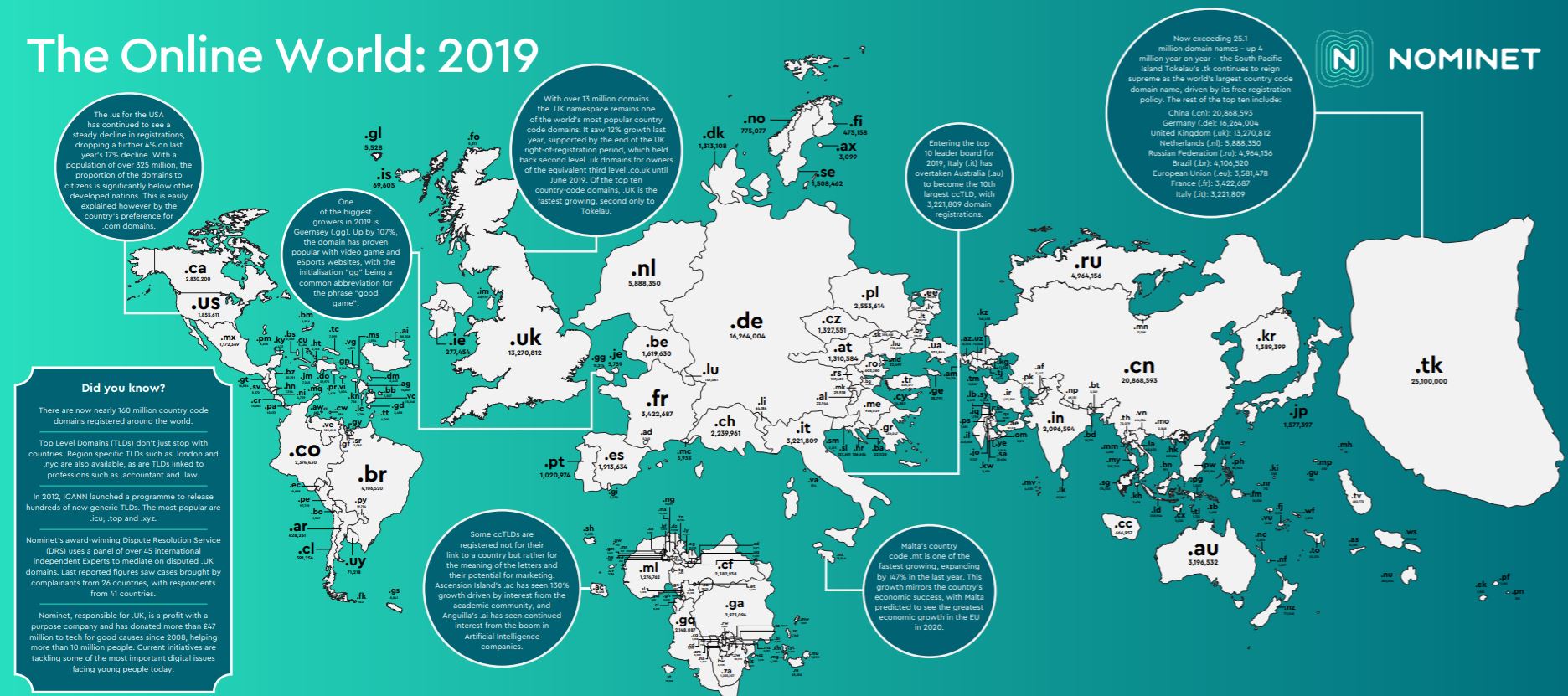In the vast expanse of the digital universe, the importance of domain names is paramount. They serve as the navigational coordinates to websites, akin to addresses in the physical world.
Among the various categories of domain names, Country Code Top-Level Domains (ccTLDs) hold a unique position. This article delves into the world of ccTLDs, exploring their definition, significance, and functioning, along with their impact on the global internet landscape.
What are ccTLDs?
Country Code Top-Level Domains are internet top-level domains, generally consisting of two letters, that are specifically designated for a country or a geographic location. These two-letter codes are derived from ISO 3166-1 alpha-2 country codes. For example, “.uk” represents the United Kingdom, “.fr” stands for France, and “.jp” is for Japan.
The Roots: How ccTLDs Came to Be
The concept of ccTLDs originated in the 1980s with the establishment of the Domain Name System (DNS). The DNS was created to simplify the navigation of the internet, replacing complex numerical IP addresses with user-friendly domain names. Jon Postel, a key figure in the development of the internet, played a significant role in the creation of ccTLDs, envisioning them as a way to organize and manage the growing number of internet users and websites globally.
The Significance of ccTLDs
Local Identity and Presence: ccTLDs offer a way for businesses and individuals to assert their presence and identity in a specific country or region. For instance, a company operating in Germany might use a “.de” domain to signal its local relevance and commitment to German customers.
SEO and Localization: From an SEO (Search Engine Optimization) perspective, ccTLDs are beneficial as they are often favored in local search results. Search engines tend to prioritize local domains for searches made in that country, which can be crucial for businesses targeting specific geographic markets.
Cultural and Linguistic Relevance: ccTLDs also cater to local languages and scripts, fostering a more inclusive internet. For example, Saudi Arabia uses “.السعودية”, and Russia has “.рф”, both in their respective scripts.
Management and Governance of ccTLDs
The management of ccTLDs is usually the responsibility of designated organizations or governmental bodies within each country. These entities are known as registries. They set the policies for the ccTLD, including registration requirements, dispute resolution, and pricing.
ICANN (The Internet Corporation for Assigned Names and Numbers) plays a pivotal role in coordinating the global DNS and thus indirectly influences ccTLD policies. However, ccTLD registries often have more autonomy compared to gTLDs (generic Top-Level Domains), allowing for tailored policies that reflect local needs and laws.
The Varied Landscape of ccTLD Policies
Registration policies for ccTLDs can vary greatly. Some countries, like Canada (.ca), require registrants to have a physical presence or connection to the country. Others, such as Tokelau (.tk), offer their ccTLDs for free or with minimal requirements, making them popular for a variety of uses, not always geographically tied to the country.
The Impact of ccTLDs on the Global Internet
ccTLDs have played a significant role in shaping the internet’s growth and structure. They have enabled local businesses and communities to carve out their own space in the digital world, respecting linguistic and cultural diversity. However, this localization also brings challenges, such as the potential for increased internet fragmentation and the complexity of managing a diverse array of domain policies.
Country Code Top-Level Domains are more than just internet addresses. They are symbols of national identity, tools for digital marketing, and gateways to cultural and linguistic diversity in the online world.
As the internet continues to evolve, the role of ccTLDs will undoubtedly adapt, reflecting the ever-changing landscape of global digital communication and commerce. Whether for a local business, a global enterprise, or an individual user, understanding and utilizing ccTLDs can unlock new opportunities and connections in the ever-expanding digital universe.
Future Prospects and Challenges
As we look towards the future, ccTLDs face both opportunities and challenges. The ongoing evolution of the internet, including the expansion of the Internet of Things (IoT) and the proliferation of new digital platforms, presents a fertile ground for ccTLDs to grow in relevance. However, this growth is not without its hurdles.
Balancing Globalization and Localization: In an increasingly interconnected world, ccTLDs must find a balance between maintaining a local identity and participating in the global digital economy. This challenge involves navigating issues like international trade, cross-border data flows, and multilingual content.
Security Concerns: As with any aspect of the internet, security is paramount. ccTLD registries must continuously invest in and update their security measures to protect against cyber threats, such as DNS attacks and domain hijacking.
Policy Harmonization: With each country setting its own policies for its ccTLD, there’s a complex patchwork of regulations affecting everything from data privacy to domain dispute resolution. Finding common ground or at least a mutual understanding among these diverse policies is crucial for the smooth functioning of the global internet.
Technological Advancements: Technological changes, such as the adoption of IPv6 (Internet Protocol version 6) and the integration of artificial intelligence in DNS management, will impact how ccTLDs operate. Staying abreast of these advancements is essential for ccTLD registries to remain efficient and relevant.
Digital Divide: The disparity in internet access and digital literacy across different regions can affect the utilization and impact of ccTLDs. Bridging this digital divide is vital for ensuring that the benefits of ccTLDs are widely accessible.
Case Studies: ccTLDs in Action
Examining real-world examples can provide valuable insights into the practical applications and implications of ccTLDs. Let’s consider a few case studies:
.nz (New Zealand): New Zealand’s .nz ccTLD is a prime example of a well-managed, community-focused domain space. The registry has implemented policies promoting transparency, security, and accessibility, making .nz a trusted and popular choice for New Zealanders.
.eu (European Union): The .eu ccTLD represents a supranational approach, serving individuals and organizations across the European Union. It exemplifies the potential of ccTLDs to transcend national boundaries while fostering a common regional identity.
.tk (Tokelau): Tokelau, a small island territory, offers its .tk domain for free, leading to its widespread adoption globally. This strategy has brought attention to Tokelau but also raised questions about the implications of such openness, including vulnerability to misuse.
The world of ccTLDs is a dynamic and complex facet of the internet’s infrastructure. As digital landscapes evolve, so too will the roles and responsibilities of these domains. For businesses, individuals, and governments, understanding the nuances of ccTLDs is crucial for navigating the online world effectively.
Whether it’s for establishing a local online presence, engaging in global digital commerce, or simply understanding how the internet is organized, the significance of ccTLDs cannot be overstated. As we continue to witness the growth and transformation of the digital realm, ccTLDs will remain key players in connecting the world, one domain at a time.
Emerging Trends and the Role of ccTLDs
As the digital landscape continues to evolve, emerging trends are shaping the role and significance of ccTLDs. Understanding these trends is crucial for anticipating future developments in the realm of digital identities.
Localized Digital Content: There’s a growing emphasis on creating and promoting localized content on the internet. ccTLDs play a vital role in this, offering a platform that inherently signals localized content and services. This trend is particularly significant in non-English speaking countries, where ccTLDs support the proliferation of content in local languages.
E-commerce and Local Markets: The rise of e-commerce has seen ccTLDs become increasingly important for businesses looking to establish trust and authenticity in local markets. A ccTLD not only helps in SEO but also boosts consumer confidence, signaling to customers that a business is legally established and operating within their region.
Digital Sovereignty: In an era where digital sovereignty is becoming a pressing concern for many nations, ccTLDs are often seen as a component of national digital infrastructure. They offer countries the ability to control their own digital space, which is particularly relevant in times of geopolitical tensions and concerns over cyber sovereignty.
Mobile Internet and ccTLDs: With the increasing use of mobile internet across the globe, ccTLDs have become more important in reaching audiences who primarily access the web via smartphones. Mobile users often look for local, quick-loading content, and ccTLDs can signal the availability of such content.
Sustainability and Social Responsibility: Some ccTLD registries have started to focus on sustainability and social responsibility in their operations. This involves using eco-friendly practices in running data centers and supporting local community projects, enhancing the social value of the ccTLD.
The Role of ccTLDs in Global Internet Governance
As integral components of the internet’s infrastructure, ccTLDs are not just technical entities but also participants in global internet governance. Discussions around internet governance often involve topics like the management of internet resources, cybersecurity, and the free flow of information. ccTLD registries and administrators are increasingly involved in these conversations, ensuring that their perspectives and the interests of their local internet communities are represented.
The Future: Opportunities and Innovations
Looking ahead, ccTLDs are poised to embrace new opportunities and innovations. This could involve advanced DNS technologies, enhanced security features, and innovative ways to serve local internet communities. For instance, blockchain technology could offer new methods for domain registration and management, providing enhanced security and transparency.
So, Country Code Top-Level Domains are much more than mere internet address extensions. They are vital components of the internet’s infrastructure, reflecting and shaping cultural, economic, and technological landscapes.
As the internet continues to evolve, ccTLDs will undoubtedly adapt and innovate, playing a pivotal role in the future of digital communication and commerce. Understanding ccTLDs is not just about understanding a technical facet of the internet; it’s about appreciating a crucial element that helps define the digital identity of nations and regions in an increasingly connected world.










